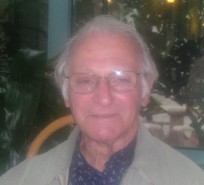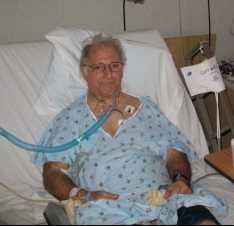Motors Away From Mesothelioma
Forty-seven beautiful years of marriage. Four loving children. Nine grandkids and four great-grandchildren who think Grandpa hung the moon.
Meet Tony Chomo.
This hard working family man teamed up with Dr. Robert Cameron to try and beat back the scourge of mesothelioma. For now, it's working: quality of life, extra time with his beloved family, and the chance to put a few more miles on the big bike's odometer have all come together.
To Heck with all this Snow
Tony and his wife Janet moved from Massachusetts to California in 1977. A career maintenance worker and licensed plumber, the day finally came when the Tony had all he could take of the brutal East Coast winters. They didn't pack up their car and move to Beverly, but they came close: the family settled in Simi Valley and has been there ever since.
In August, 2006, Tony was involved in a minor motorcycle accident. His injuries seemed minor, and Tony went home.
One month later, he found himself having a hard time breathing normally. The robust, hale, and active grandfather was experiencing labored breathing and, fearing a medical problem, went to the emergency room at Northridge Hospital. An EKG ruled out a heart attack, but fluid was found surrounding his lung. The doctor drained the effusion. The next week, his doctor announced that tests on the fluid revealed abnormal mesothelial cancer cells. The diagnosis? Mesothelioma.
Finding the Best Treatment Possible
Tony next saw an oncologist. As word of Tony's illness spread, a friend told Tony about Dr. Robert Cameron at UCLA's David Geffen School of Medicine. Dr. Cameron, head of the mesothelioma program at UCLA and director of the Punch Worthington Research Lab, saw Tony in October. Dr. Cameron reviewed the reports from Northridge Hospital and ordered new tests to confirm the diagnosis of mesothelioma. Tony and Dr. Cameron again met and discussed surgery and other treatment options.
For Tony, the eternal optimist, the family provider, the rock of stability who could nonetheless let loose on the open road atop 1200cc's of throaty motorcycle muscle, the options seemed slim. Mesothelioma has no "cure" in the sense that a medical procedure or combination of drugs can make it go away forever. In fact, many providers regard mesothelioma patients as "hopeless" and recommend no treatment whatsoever.
Dr. Cameron, however, reviewed the options with Tony in a compassionate yet objective and forthright way. They discussed the differences between EPP and pleurectomy with decortication (P/D) surgery, and talked about treating mesothelioma as a chronic condition which Tony would have to deal with the remainder of his life-like high blood pressure or diabetes. The focus became choosing a treatment that would hopefully extend life and, even more importantly, extend the quality of life.
Tony chose to undergo a pleurectomy with decortication surgery on January 9, 2007. Prior to the surgery, Tony and his family enjoyed a wonderful Christmas together, taking special meaning from the chance to be together.
Fighting Back
Dr. Cameron performed the pleurectomy and cut out all of the visible tumor attached to Tony's chest cavity and organs.
Tony required ten days of recovery in the hospital. Dr. Cameron described Tony's medical condition and surgery in detail.
"Well, I had talked to them on the phone after we finally got the confirmation that this was mesothelioma. And I told him that he was otherwise fit, had no other medical problems, which is also a reason why people can't have surgery. If their heart is bad or they have a history of strokes and other problems, they can't undergo general anesthesia, then they can't have surgery.
But he was otherwise fit. He had disease that appeared to be limited just to that part of the chest. He did not have obvious spread to his lymph nodes. And so he seemed to be actually a quite good candidate to have the pleurectomy procedure done so I recommended that. They finally decided he thought he should go ahead with the surgery.
Parts of things are removed like part of the diaphragm is removed that's touching the tumor. Routinely, we remove lymph nodes that are in the area of the lung and the middle of the chest to see where the tumor has spread. We try not to remove the lining of the heart. The lining of the lung, the pleura, butts up against the lining of the heart. And both are similar types of lining cells. So you can get tumor into the heart sac, which is not a good thing because then the tumor spreads directly onto the heart. So we purposely try not to go into that heart sac and take all the tumor off that, which is somewhat tedious.
He did reasonably well. Many people have problems with abnormal heart rhythms and the pain, covering up phlegm and that kind of thing. But he seemed to get through that pretty reasonably well. He's a pretty strong person.
Then Tony did radiation on the body. What's really tricky about radiation is that you technically want to radiate every place where the tumor was present. But that involves every single surface of the lung, the diaphragm, the middle of the chest and the ribs. That's a big area. Also, the lung itself is very sensitive to radiation damage. So you have to have a lot of fancy treatment planning to be able to deliver radiation to all those areas and yet not hurt the lung."
Tony is proud to say he has not taken any prescription pain medication since February. He feels soreness at the incision site but manages it without medication. Tony tries to go on walks two to three days a week to stay active. He tires easily and notices significantly decreased breathing capacity. He loves riding his motorcycle with his buddies whenever he gets a chance. He plans to visit Las Vegas in the coming weeks. He has gone on several bike rides with a friend in the mountains and in Ojai.
A Loving Couple
Tony and his wife Janet always lived an active lifestyle. They own Harley-Davidson and Suzuki motorcycles and enjoyed taking the motorcycles on tours and trips. Prior to becoming motorcycle enthusiasts, they owned boats and would go scuba diving. An inveterate dirt bike rider, Tony enjoyed the thrill of showing his grandchildren how to ride off-road.
Tony, Jr. followed in his father's footsteps and worked in the family plumbing and heating business until opening his own venture.
No job or occupation is as dear to Tony as that of "grandpa." Their home is daily filled with the laughter, chatter, and inevitable caterwauling that comes from babysitting robust youngsters.
Prior to his diagnosis, Tony had no plans of retiring. He loved his job and loved the satisfaction of working, of doing a job well, and of providing for his family. Tony's long list of devoted clients includes countless customers who had been with him for over twenty-five years.
Since his surgery and radiation, Tony cut out work completely. Working fewer hours was one of the hardest adjustments, because his identity was completely entwined with his work ethic. He loved his job and usually ran circles around younger guys when it came to the energy and passion of work. After his surgery, he simply began refusing many new jobs and contracts as the business has come to a virtual halt.
Tony's life has changed, but he faces those changes with fortitude and optimism. His surgery has given him a lease on life he might not otherwise have, and each day spent with his children, grandchildren, and great-grandchildren is precious indeed.
*** POSTED SEPTEMBER 18, 2007 ***
An Update -- 5/4/2009
Tony is currently going through another chemotherapy cycle. His doctors found a tumor in his back, but luckily it is not connected to any of his vital organs. His wife Janet said that after his last PET scan the tumor had shrunken by 1/2.
Tony's doctors are hoping that the tumor will be completely destroyed by the chemotherapy. Janet is also very hopeful.
His doctors also have a "freezing procedure" that they believe will shrink the tumor even more and they will be performing this procedure soon. Aside from the chemotherapy, Anthony is still riding his Harley and recently traded in their motorhome for a brand new Ferrari. Janet said, "Anthony felt really young when he got his first ticket in the new Ferrari". They are taking each day as it comes and are grateful for all their family and friends that have helped them through this ordeal.
An Update -- 9/1/2009
Tony just finished a series of tests at UCLA in July in which they did a needle biopsy and then froze the specimen taken. These tests give Tony and his doctors a better idea of his progress from the chemotherapy.
Tony says, " I am feeling really good and still doing all the things I love to do." He is still enjoying both his Ferrari and his Harley and hopes the nice weather lasts a few more months. Tony's outlook is very positive and he takes each day as it comes. His next PET scan is scheduled for September 18, 2009.
He hopes at that time the tumor in his back will be completely gone.
An Update -- 3/2/2010
Tony continues to charm anyone who listens to his matter-of-fact take on living with mesothelioma. He handles any “flare-ups” and follow-up treatment with the air of calm and casualness. Recently Dr. Cameron saw two small spots return which Tony will have treated with cryoablation again later this month. Tony is unperturbed, “So you’re uncomfortable for one day, I can handle that. What the hell.”
Tony does not pass up an opportunity to improve his quality of life. “Might as well, while I can”. He is currently overseeing home improvements and lush landscaping to his new home, customized to fit his taste.
He and Jan are starting to make a habit of visiting Italy every year. They thoroughly enjoyed their trip in October to Tuscany, Florence and Rome. The highlight for Tony was touring the Ferrari factory in Maranello, “That was the best damn trip!” They continue to regularly visit Las Vegas, always riding in style in Tony’s black Ferrari.
Tony never hesitates to treat himself after all the aggravation he has been through.
An Update -- 12/21/2011
It’s been four years since Tony was diagnosed thus surpassing all estimates of his continued resiliency in fighting mesothelioma. For him it’s about the little things, such as housing six grand-kids from all over the country over the holidays no matter how much ruckus they bring with them or catching a new car show whenever he can, that remind him how grateful he is to be around.
His status is by no means problem free though. This past year Tony had chemo for the first time after new growths were discovered close to his spine. Due to their location, he underwent several rounds of Avastin and Alimta to shrink the tumors before doctors could recommend cryoablation. The freezing technique used in cryoablation could potentially “shatter” his spine if done to close to it. This past week during his appointment, Tony received some good news from Dr. Cameron’s office. The growths are shrinking and he will probably be able to undergo cryoablation in January or February.
As the New Year approaches, Tony looks forward to another trip to Italy with his wife Janet and more car shows in Vegas! He recently toured The Pacific Meso Center’s Mesothelioma Research Laboratory before his clinic appointment and is impressed by all the exciting things happening to improve patient’s lives and life-expectancy. He candidly states, “What can I say? Dr. Cameron was the best thing that ever happened to me after being diagnosed.”


